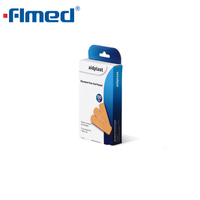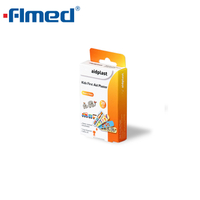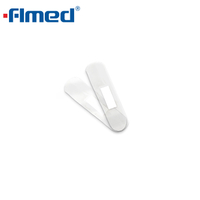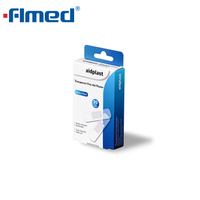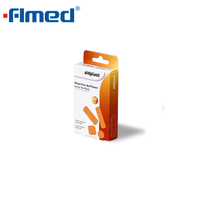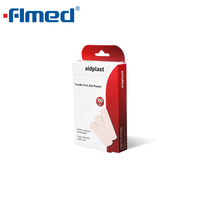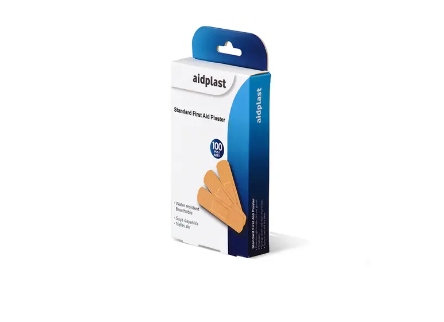
A First Aid Plaster, commonly known as a band-aid, is an essential item in medical kits, particularly for minor injuries. It is a small adhesive bandage used to cover and protect small wounds, cuts, or abrasions from infection and external contaminants. First aid plasters are widely used in homes, workplaces, and medical facilities, providing a quick and easy solution for minor injuries.
In this article, we will explore the components, types, and uses of first aid plasters, as well as their importance in wound care management. We will also discuss their role in various industries, including factories, distributors, and retailers. Additionally, we will examine the benefits of using First Aid Plasters and how they contribute to overall workplace safety and hygiene.
What is a First Aid Plaster?
A First Aid Plaster is a small adhesive bandage designed to cover minor wounds, cuts, or abrasions. It consists of three main components:
Adhesive Strip: This is the sticky part of the plaster that holds it in place on the skin.
Absorbent Pad: The central part of the plaster that covers the wound, designed to absorb any blood or fluids.
Protective Layer: A thin layer that protects the wound from dirt, bacteria, and other contaminants.
The adhesive strip is typically made from a flexible material such as fabric or plastic, which allows the plaster to conform to the shape of the skin and stay in place. The absorbent pad is often made from cotton or other absorbent materials, and it is designed to prevent the wound from sticking to the plaster, reducing the risk of reopening the wound when the plaster is removed.
Types of First Aid Plasters
There are several types of First Aid Plasters available, each designed for specific purposes and environments. Some of the most common types include:
1. Standard Adhesive Plasters
These are the most common type of first aid plaster, used for covering small cuts and abrasions. They come in various sizes and shapes to accommodate different wound types. Standard adhesive plasters are typically made from fabric or plastic and are designed for everyday use.
2. Waterproof Plasters
Waterproof plasters are designed to protect wounds in wet environments, such as when swimming or bathing. They are made from a waterproof material that prevents water from entering the wound, keeping it dry and protected.
3. Fabric Plasters
Fabric plasters are made from a flexible, breathable material that allows the skin to breathe while providing protection. These plasters are ideal for use on joints or areas of the body that move frequently, as they are more flexible than plastic plasters.
4. Transparent Plasters
Transparent plasters are made from a clear material that blends with the skin, making them less noticeable. These plasters are often used for cosmetic reasons, as they provide discreet protection for minor wounds.
5. Antibacterial Plasters
Antibacterial plasters are infused with an antiseptic solution that helps prevent infection in the wound. These plasters are particularly useful for wounds that are at a higher risk of infection, such as cuts or scrapes that occur in dirty environments.
The Importance of First Aid Plasters in Wound Care
First aid plasters play a crucial role in wound care by providing a protective barrier that helps prevent infection and promotes healing. When a wound is left exposed, it is more susceptible to infection from bacteria, dirt, and other contaminants. By covering the wound with a plaster, the risk of infection is significantly reduced.
In addition to protecting the wound, first aid plasters also help to absorb any blood or fluids that may be oozing from the wound. This helps to keep the wound clean and dry, which is essential for the healing process. Furthermore, the adhesive strip helps to keep the plaster in place, ensuring that the wound remains protected even during movement.
Applications of First Aid Plasters in Various Industries
First aid plasters are used in a wide range of industries, including manufacturing, retail, and healthcare. In factories, for example, workers are often exposed to sharp tools and machinery, which increases the risk of cuts and abrasions. Having a supply of first aid plasters on hand ensures that minor injuries can be treated quickly and effectively, reducing the risk of infection and minimizing downtime.
For distributors and retailers, first aid plasters are a popular product that is in constant demand. They are a staple item in first aid kits and are often purchased by consumers for use in the home, workplace, or while traveling. Offering a variety of first aid plasters, including waterproof, fabric, and antibacterial options, can help retailers meet the needs of their customers and increase sales.
Benefits of Using First Aid Plasters
There are several benefits to using first aid plasters for wound care, including:
Protection: First aid plasters provide a protective barrier that helps prevent infection and keeps the wound clean.
Convenience: Plasters are easy to apply and remove, making them a convenient option for treating minor injuries.
Variety: There are many different types of plasters available, allowing users to choose the best option for their specific needs.
Cost-Effective: First aid plasters are an affordable solution for wound care, making them accessible to a wide range of consumers.
In conclusion, First Aid Plasters are an essential tool in wound care management, providing protection, convenience, and affordability. Whether used in homes, workplaces, or medical facilities, first aid plasters play a vital role in preventing infection and promoting healing. For factories, distributors, and retailers, offering a variety of first aid plasters can help meet the needs of consumers and contribute to overall workplace safety.

 English
English
